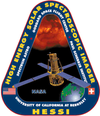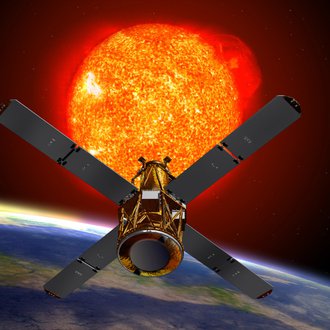RHESSI


RHESSI was a NASA Small Explorer Mission dedicated to the study of particle acceleration and energy release in solar flares. The satellite was launched into low Earth orbit on a Pegasus rocket on February 5, 2002. The only instrument on board was an imaging spectrometer operating in the X-ray and gamma-ray ranges. This allowed for the first time that high-resolution images and spectra of solar flares in the energy range from 3 keV to 17 MeV could be obtained simultaneously with high time and energy resolution. The mission was developed and carried out by teams from the US (UCB Berkeley und Goddard Space Flight Center) and Europe (Paul Scherrer Institute and ETH Zurich).
Germany was involved in the RHESSI mission in several ways:
- The ground station in Weilheim of the German Space Operation Center (GSOC), operated by the German Space Agency DLR , provided additional downlink capacity for RHESSI when needed.
- Radio data from the Observatory for Solar Radio Astronomy in Tremsdorf Observatory for Solar Radioastronomy (OSRA) in Tremsdorf were provided to the RHESSI data center.
- The AIP participated in the joint data analysis of RHESSI and radio data.
During a solar flare energy stored in coronal magnetic fields is released impulsively. A significant portion of this energy is contained in high-energy electrons. These electrons produce hard X-rays when they interact with the solar atmosphere. Therefore, X-ray spectra and images contain important information about particle acceleration processes in flares. Since energetic electrons also produce radio radiation, this provides an important complementary approach to study the particle acceleration problem.
After 16 years of successful operation, RHESSI was decommissioned in August 2018. RHESSI data, however, continue to be used intensively, especially since the data structure is so flexible that qualitatively new information can be extracted from it using newly developed analysis methods.
Involved AIP sections and groups:
Solar Physics